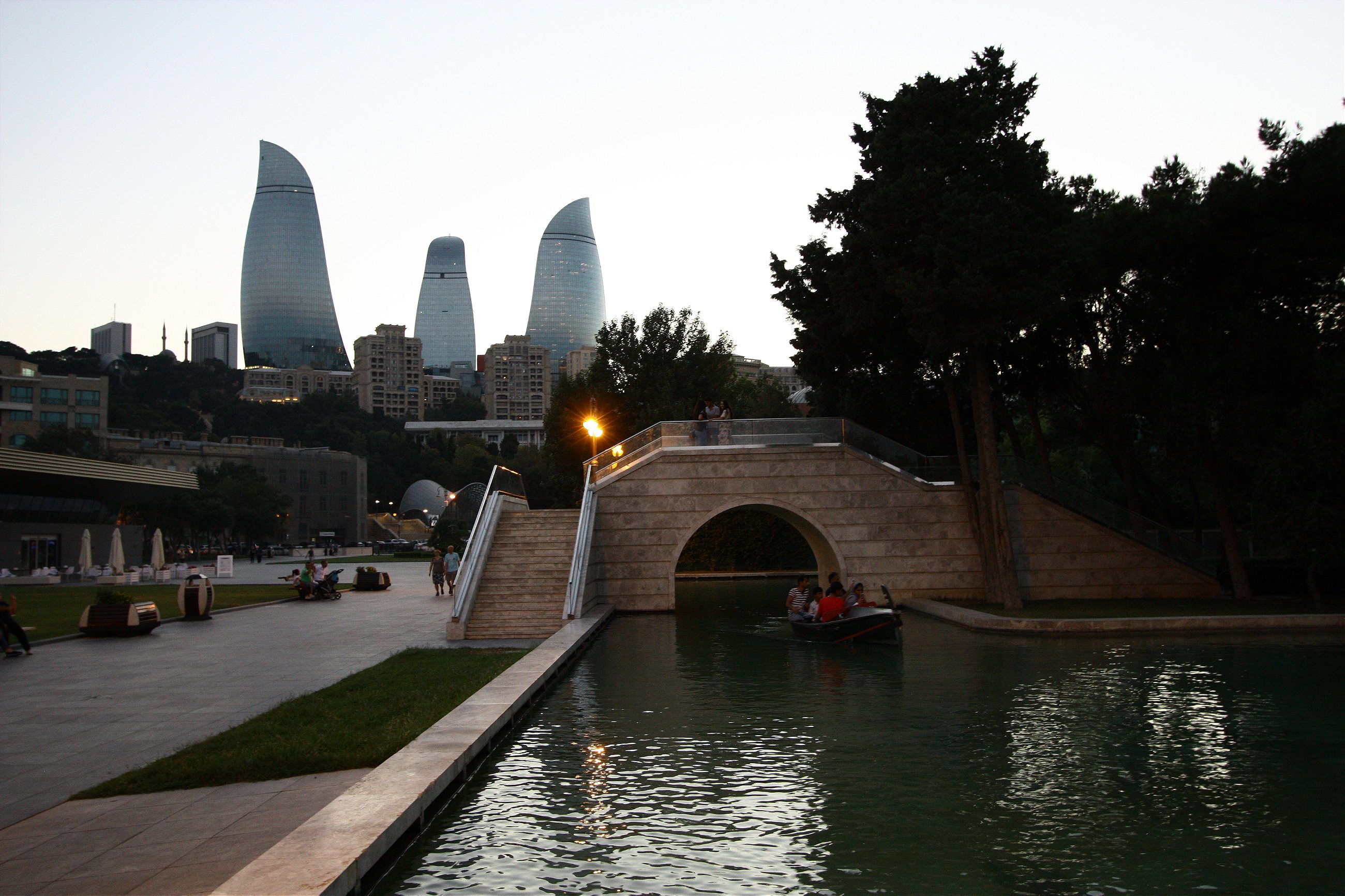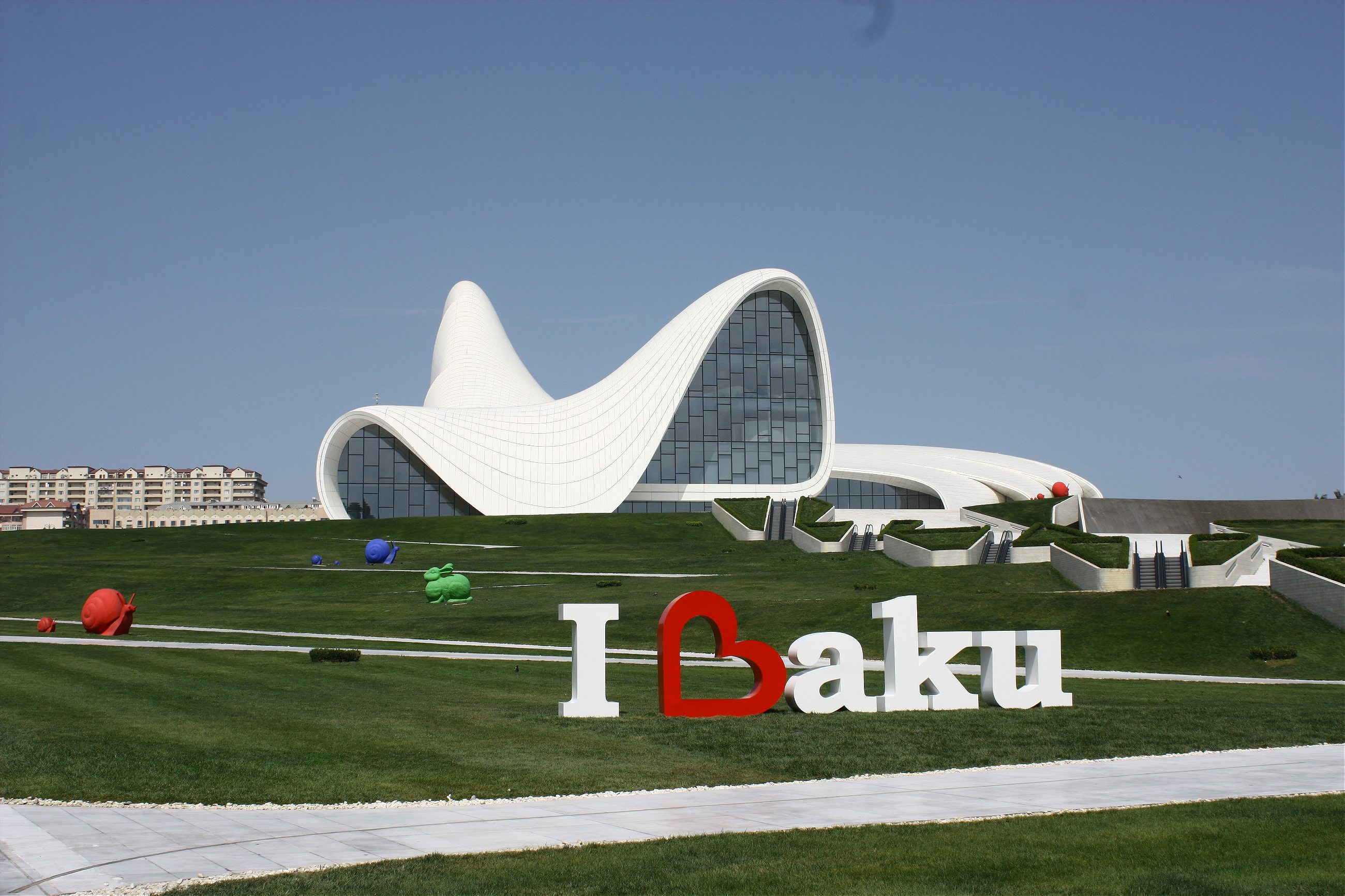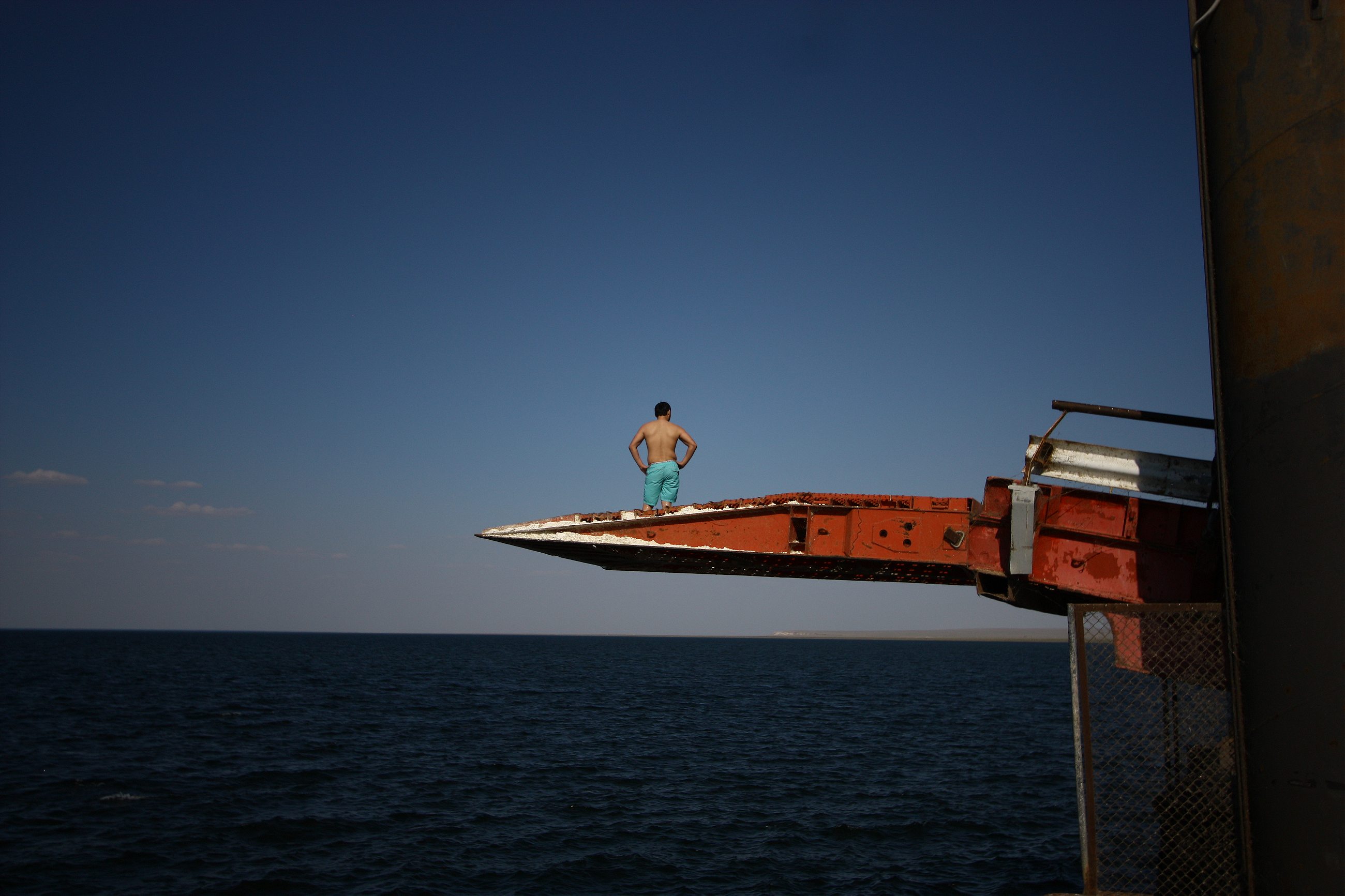Countries on the fuzzy edge between two continents are grappling with what it means to be in Europe or Asia today.
For Roads & Kingdoms’ Edge of Europe series, writer Joshua Kucera is traveling along the disputed border between Europe and Asia, from Istanbul to the Russian Arctic, to explore the ancient history and current politics of how we divide up the world.
Beside a busy road on the outskirts of Baku, Azerbaijan, in the nondescript exurban village of Fatmayi, stands a small, hand-painted sign bearing the Azerbaijani flag and two arrows pointing in opposite directions: one toward “Avrupa” and the other to “Asiya.” It seems an unlikely place for a continental divide, with no apparent geographic features worthy of that distinction; the sign stands between an auto parts shop and a large pile of construction waste.
But the Azerbaijan Geographical Society, which erected the sign in 2013, believes that this is the true border between Europe and Asia. While the spot’s significance may not be visible to the casual visitor, Azerbaijani geographers have determined that it lies on the continuation of the watershed of the Caucasus Mountains. And that means that a small slice of Azerbaijan—about one-sixteenth of the country’s territory—lies in Europe.
Whether or not Azerbaijan is a European country has long been a fraught question, lying at the heart of the country’s national identity and its relationship to Islam, Russia, democracy, and modernity. Since gaining independence upon the collapse of the Soviet Union in 1991, Azerbaijan has portrayed itself as an Istanbulesque bridge between East and West. Baku hosted the Eurovision song contest in 2012 and was also a “capital of Islamic culture” in 2009. It organized the first (and probably only) European Games in 2015, and it will host the Islamic Solidarity Games in 2017.

“Taking advantage of its geographical position, resources and potential, we are realizing the role of a ‘bridge’ between East and West—with origins in the historical past and oriented toward the future,” President Ilham Aliyev wrote in his 2007 book, I Believe in My Azerbaijan. And Aliyev’s wife executive-produced an English-language film adaptation of Ali and Nino, the 1937 book that has been adopted as a sort of national novel, in which the the love between the two title characters—an Azeri Muslim boy and Georgian Christian girl—represents Baku’s position between Europe and Asia. Ali describes his city this way in the book:
Outside the Old Wall was the Outer Town, with wide streets, high houses, its people noisy and greedy for money. This Outer Town was built because of the oil that comes from our desert and brings riches. There were theaters, schools, hospitals, libraries, policemen and beautiful women with naked shoulders. If there was shooting in the Outer Town, it was always about money. Europe’s geographical border began in the Outer Town, and that is where Nino lived. Inside the Old Wall the houses were narrow and curved like oriental daggers. Minarets pierced the mild moon, so different from the oil derricks the House of Nobel had erected.
But geographers haven’t necessarily agreed with Ali or Aliyev. Although there are varying interpretations of how the border between Europe and Asia crosses the Caucasus isthmus between the Black Sea and Caspian Sea, they nearly all pass north of Azerbaijan, placing the country entirely within Asia. The Azerbaijan Geographical Society’s effort—part of a larger, international project, including geographers from Russia and Kazakhstan—aims to change that.
“Look at me. Do I look Chinese?”
“Look at me. Do I look Chinese?” Ramiz Mammadov, the chair of the society, asks me. “I’m just as European as you.”
Mammadov blames Russian chauvinism for the fact that Azerbaijan is not considered European. He points out that the last effort to redefine the border was carried out in the 1960s by Soviet Russian geographers, who determined that the correct border was the Kuma-Manych Depression, a series of small rivers that pass to the north not just of Azerbaijan but of the Russian Caucasus such as Chechnya and Dagestan. “This is where Muslims live. Their way of life meant that they couldn’t be European, so they were kept in Asia,” Mammadov says. The border he has identified, he argues, is a corrective to that unscientific approach. “Economics, lifestyle, customs: These are all dynamic factors, which can change. What doesn’t change? The watershed of the Caucasus. So, if lifestyle and customs can change in 40 years, do we change the border every 40 years?”
According to Eduard Murzaev, one of those Soviet scholars, the geographical societies of the three Transcaucasian republics—Armenia, Azerbaijan, and Georgia—were surveyed as part of the 1960s border project and asked where they thought the border should be. Murzayev remembers the Azerbaijani delegation (along with the Armenians) arguing that the line should be the Kuma-Manych Depression, i.e., that they should be in Asia. It recalled the opening scene of Ali and Nino, in which the Russian teacher is giving a geography lesson to his mostly “Mohammedan” students:
“The natural borders of Europe consist in the north of the North Polar Sea, in the west of the Atlantic Ocean, and in the south of the Mediterranean. The eastern border of Europe goes through the Russian Empire, along the Ural mountains, through the Caspian Sea, and through Transcaucasia. Some scholars look on the area south of the Caucasian mountains as belonging to Asia, while others, in view of Transcaucasia’s cultural evolution, believe that this country should be considered part of Europe. It can therefore be said, my children, that it is partly your responsibility as to whether our town should belong to progressive Europe or to reactionary Asia.”
The professor had a self-satisfied smile on his lips.
We sat silent for a little while, overwhelmed by such mountains of wisdom, and the load of responsibility so suddenly laid upon our shoulders.
Then Mehmed Haidar, who sat on the back bench, raised his hand and said: “Please, sir, we should rather stay in Asia.”
There are people today who apparently agree that Azerbaijan should stay in Asia, or at least that it shouldn’t make such a big deal about trying to belong to Europe. Mammadov says that some of his higher-ups have asked that he suspend the border project because it is “too political.” (Mammadov wears two hats, as the head of the geographical society and as the director of the Institute of Geography at the Azerbaijan National Academy of Science. The former is an NGO, while the latter is run by the state.) He blames midlevel officials: “If it went to the president, he would support it. He’s farsighted and understands these things.”
Ali and Nino ends elegiacally, lamenting the dying beauty of Eastern tradition and predicting that Baku would inexorably Europeanize. And it was correct: At least by all the superficial standards that Ali used, Baku has lost its “Asianness.” Everyone eats at a table now rather than on the floor, and women are more likely to wear miniskirts than the veil. The old city, Ali’s Oriental redoubt, has been carefully restored and is now home to European embassies and carpet shops for tourists. The oil derricks are still outside the wall, but several foreign oil services companies, the successors to the Nobels—whose prizes were funded, in part, by their dominance of the 19th century oil boom here—have offices in restored Old Town buildings.

I meet Altay Goyushov, a historian and one of Azerbaijan’s leading public intellectuals, in a café just a couple of blocks from the Old Town. I ask him a brief, open-ended question about Azerbaijan’s relationship to Europe, and he effortlessly launches into a sweeping overview of Azerbaijani history.
For most of Azerbaijan’s history, he explains, people here didn’t consider themselves either Western or Eastern. “We knew who we are, and we didn’t think about it. It wasn’t important to us,” he says.
But after Azerbaijan was colonized by Russia in the 19th century, Russian intellectual trends began to filter in. This was the era of the debate between the Russian “Westernizers,” who advocated adopting European customs and political ideas, and “Slavophiles,” who argued that Western ideas were unsuitable for Russia, which should follow its own path. “And this notion came to us that the West was developed, and we are underdeveloped, and that this is the difference between us,” Goyushov explains.
Azerbaijan’s relationship to the West has been an enduring theme in Azerbaijani literature, starting well before Ali and Nino. Goyushov recommends the first modern play in Azerbaijani literature, The Botanist Monsieur Jordan and the Sorcerer-Dervish Mastali Shah, an 1850 comedy by Mirza Fatali Akhundov in which a French scientist butts heads with a superstitious mullah over the upbringing of a promising Azeri youth.
In the 19th and 20th centuries, Azerbaijan developed a rich satiric literature, and jokes about Azerbaijan’s underdevelopment vis-a-vis Europe were a constant. “All of Azerbaijan literature is like this, to compare ourselves to the West, to criticize ourselves and praise the West—their development, their education, all these things,” Goyushov says.
For the last century, Azerbaijan’s cultural elite has been dominated by Westernizers, but that monopoly has eroded somewhat in post-Soviet Azerbaijan. “The West was a kind of ideal, and that still existed here until the late 1990s, but now it’s changing,” Goyushov says. “The West is losing its attraction. People are more aware about its interests, its greed.”
The anti-Western sentiment in Azerbaijan is still far from dominant, but it takes many forms: Islamism, nationalism, leftism. Even Baku’s liberal dissidents are disillusioned with the West for its close ties with Azerbaijan’s dictatorial government, in which “Western values” are sacrificed for the sake of geopolitics. And the government, too, has been increasingly distancing itself from a purely Western identity in order to justify its lack of adherence to Western norms on democracy and human rights.
All this has put Azerbaijan’s Westernizers on the defensive. “It’s much more difficult now than it was in the 19th century for Akhundov,” Goyushov says, referring to the satirical playwright. “He didn’t have a serious opponent. It was much easier to oppose those poor mullahs and their stupid ideas. Now you have much more sophisticated kind of defenders of this anti-Western sentiment.”
“It was much easier to oppose those poor mullahs and their stupid ideas. Now you have much more sophisticated kind of defenders of this anti-Western sentiment.”
A couple of days later I left Baku on a ferry across the Caspian Sea to Aktau, Kazakhstan. (Mammadov, the geographer, approved of this route: “Yes, that’s exactly where the border goes!”) My boat, the Professor Gül, had seen many better days, presumably when it plied the Poland-Sweden route (judging from the languages on the safety placards).
A hundred years ago, this journey represented leaving the last traces of Europe behind for the unadulterated East of Central Asia. “Baku is one of the last refuges of the horse tram and the kerosene street-lamp,” wrote British journalist Stephen Graham when he visited in 1916. “It is only in the eastern quarter”—that is, Ali’s old town—“that the town has charm.” And when he sailed east from Baku, he wrote: “Leaving Europe for Asia, you sit aft and watch her to the last. And the retreating lights of Baku are the lights of Europe.”
These days that distinction isn’t so easy to make. Aktau is a bit of a dusty outpost, noteworthy mainly as Kazakhstan’s main port on the Caspian. But the streets are lit, and there is public transportation, and if Ali saw it, he’d no doubt approve of its theaters, schools, hospitals, libraries, policemen, and beautiful women with naked shoulders.

Unlike Azerbaijan, Kazakhstan has a real geographical claim to being part of Europe: According to most conventions, the Ural River, which flows north from the Caspian Sea into Russia, forms part of the Europe-Asia boundary. And if you accept the Azerbaijani geographers’ new border, about one third of Kazakhstan, the ninth-biggest country by land in the world, is within Europe.
But does that mean Kazakhstan is European? Its government, like Azerbaijan’s, has positioned itself as between Europe and Asia, East and West. It’s Muslim and borders China, and Kazakhs were historically nomadic. But Kazakhstan took great pains to join the Union of European Football Associations, the governing body for European soccer, even offering to change its time zone to move it temporally closer to the heart of Europe, if not geographically. (That gesture ended up not being necessary, and UEFA took in Kazakhstan as, and when, it was.) The president, Nursultan Nazarbayev, created a new capital in the middle of the frigid steppe and has branded it “the heart of Eurasia.”
“Central Asia since ancient times has been considered the crossroads between East and West, the place where Europe and Asia, Christianity, and Islam meet, where not only do the continents fuse but exchanges of cultural values, ideas, and goods take place,” Nazarbayev said in 2000. “We can say that in an age of global integration, when traditional borders and barriers yield to a new reality— contemporary communications networks, advanced technology— our geopolitical position is our greatest treasure.”
In spite of Nazarbayev’s efforts, it doesn’t seem that Kazakhs see themselves as very European, and the whole border-drawing enterprise seems to have engendered a good amount of skepticism in Kazakhstan. When the new border research was announced, a local news story headlined “A Third of Kazakhstan Belongs to Europe” reported that Kazakhstan might “be deprived” of some of its territory as a result. The Kazakh geographers who have been working on this didn’t respond to my request for an interview.
Kazakhstan has a couple of Europe-Asia monuments along the old border, including a Soviet-era obelisk in the city of Uralsk and a bridge over the Ural River in Atyrau that has signs marking “Asia” and “Europe” on each side. I instead headed to Aktobe, a city farther to the east, close to the new border, which has moved the city from Asia into Europe.
I meet with Rasbergen Makhmudov, an oil geologist and amateur geographer who wrote a story for a local news website supporting the idea of the more easterly border. He told me that he got started on the project after reading his grandchildren’s school textbooks, which used the old border, and has tried—thus far to no avail—to get them to use the new border instead. But he insists there is no cultural significance to the Europe-Asia border and that it should be based on geological grounds, in this case, because a range of hills known as the Mugodzhars runs along the edge of the East European Platform. This, though, is a relatively insignificant geological feature, and most continents—including Eurasia— have their own tectonic plate. All of which Makhmudov acknowledges: “Eurasia already has been divided. I just think the division should be more accurate.”

I bought a ticket out of Aktobe on a train north to my next stop along the border, in Russia. But I missed the train, and while I was at the station’s ticket window sorting out what to do, a taxi driver kept pestering me. I generally consider taxi drivers who wait at train stations and airports to be among the lowest forms of humanity. Having missed my train, as well as lunch, I wasn’t as patient as I might have been. I said some intemperate things. As karma would have it, I ended up having to hire the driver to take me to a station farther up the line so I could catch up with my train. Once we were on the road I apologized for cursing at him and tried to explain that where I was from people didn’t accost you like that while you were trying to conduct your business.
“That’s OK,” he said. “I apologize that we behave like that.” I said that wasn’t necessary; it was their country, and they can behave how they want, and some more culturally relativist things. He continued: “You know, people always criticize America for starting wars everywhere, but I think they do it right. If they didn’t do that, everyone else would always be fighting with one another.” It was an analogy I wasn’t entirely comfortable with, but with that, I was off to Russia.
